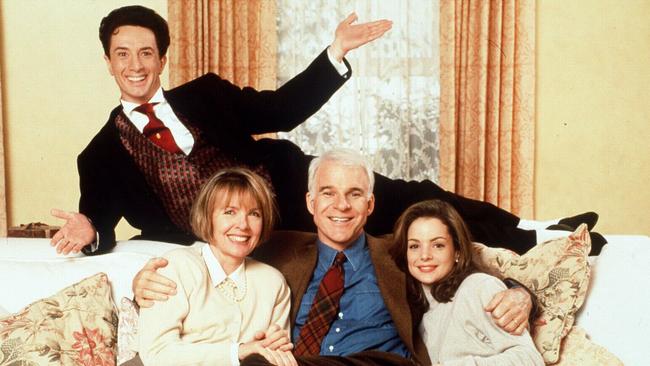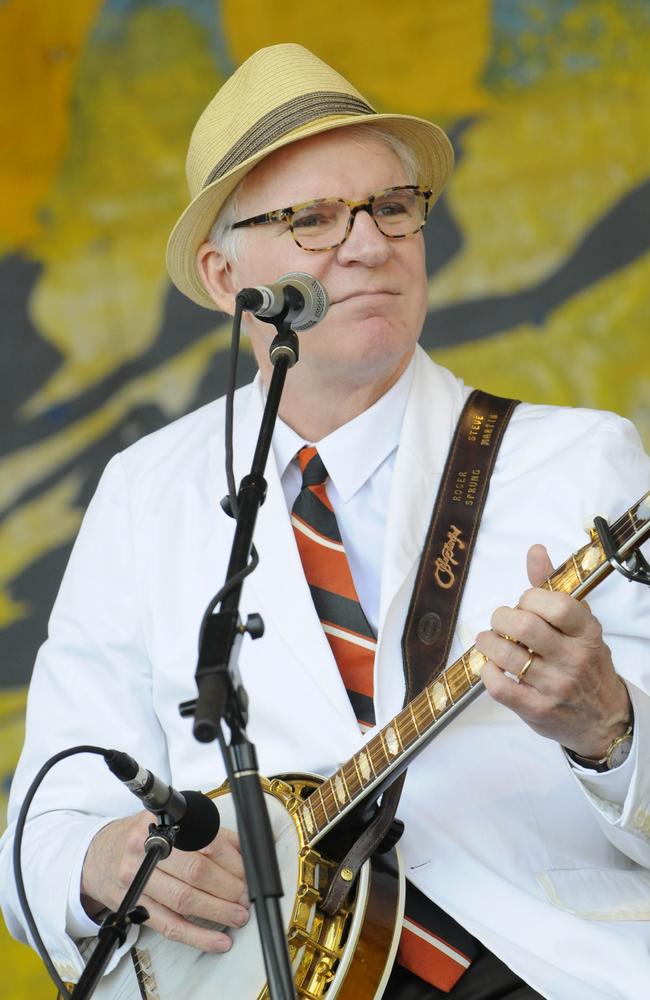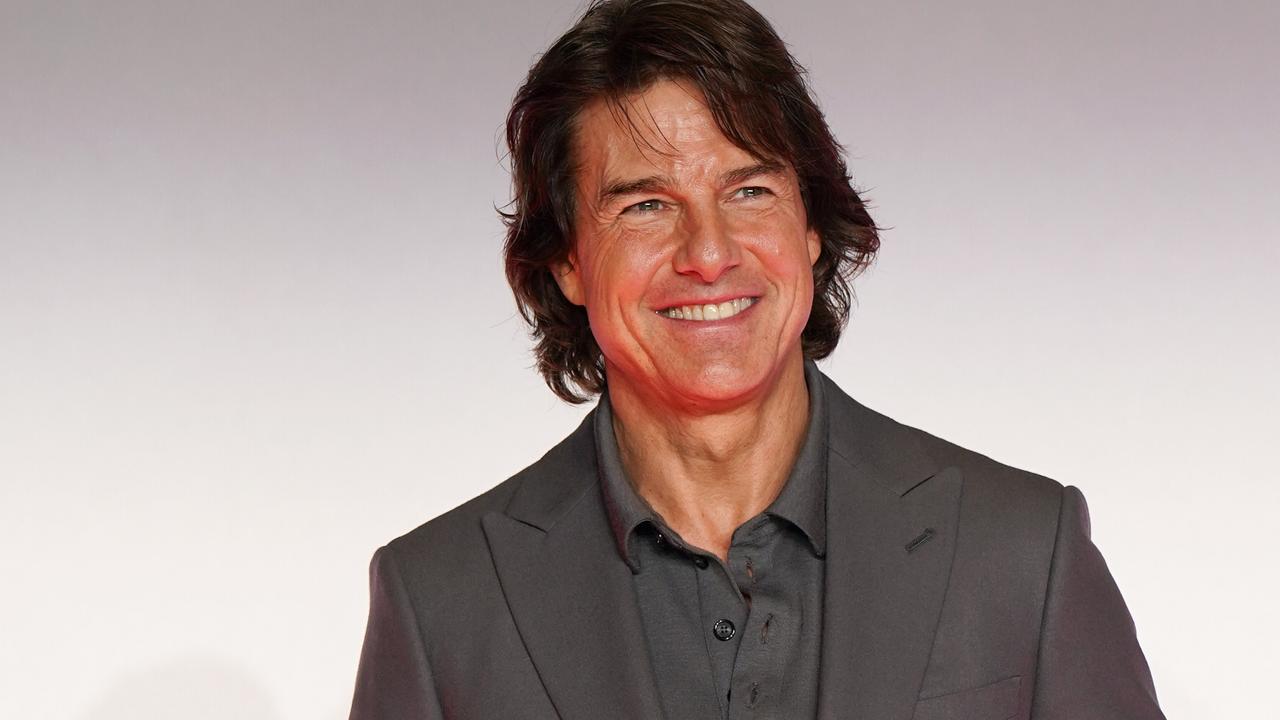Steve Martin: Everyone’s favourite movie dad
Comic legend Steve Martin talks about dealing with hecklers and playing the banjo as he revels in being a father at 71.
You became everybody’s favourite movie dad thanks to ’80s and ’90s classics such as Planes, Trains & Automobiles, Father Of The Bride and Parenthood. Did you enjoy that?
It’s funny, but I didn’t think that about myself. I did some father roles, but I never thought, “I’m going to make that my thing.” I’m not an action star, so I can’t be a guy out there with a gun. Those films are sentimental films and that’s not a negative — those were the sorts of films I was drawn to as a kid. People respond to those films.
When I was younger, I was selfish and focused on my career. Now I’m just hanging around
You only became a father yourself aged 67, in 2012 [Martin married American journalist Anne Stringfield in 2007]. What are the benefits of being an older dad?
Oh, it’s fantastic — you have all the time in the world. You’re all set and secure in life, and you’re not building your career, so you have a lot of time. When I was younger, I was selfish and focused on my career. Now I’m just hanging around the house playing with [my daughter]. It’s great.

You became famous as a stand-up comedian, but you’ve said that when you stopped doing shows, you didn’t think about it again for 25 years. How’s that even possible?
It’s totally easy: it was done. When something is done, it’s done, and you don’t even have affection for it. It was done and I was on to something that was much more exciting to me, which was movies. The standard line about artists who are painters is that you don’t finish a work, you abandon it, and that’s kind of true. I had painted myself in a corner with stand-up comedy. There was no place to go with it.
Back in your stand-up days, how did you deal with hecklers?
When I was performing in smaller clubs, I dealt with them like any comedian does — have a line that puts them down and that makes the audience laugh. But it depends on how earnest they are. If they’re really earnest, you have to get them removed because they’re stopping the show. If they’re just drunk, that’s a different thing. But then when I started playing bigger arenas — 25,000 people — hecklers weren’t really a problem. I couldn’t hear them.

In the past decade or so, you’ve focused more on playing music with your backing band, the Steep Canyon Rangers, rather than doing movies. Were you tired of acting?
Probably a little bit, but playing more music just evolved naturally. I’ve played the banjo since I was a kid — for more than 50 years — and I used it in my comedy shows. Then, in the past decade, I got seriously into playing with a band again. I’d always written songs, but I never did anything with them before in my life. And then I put out the bluegrass album [The Crow: New Songs For The Five-String Banjo in 2009] and it won a Grammy. It was the strangest thing. It was like, how did that happen?
I got involved because I was so jealous that Kevin Kline got The Ice Storm
You’re back on the big screen in war drama Billy Lynn’s Long Halftime Walk, in which you play a bombastic, power-hungry football team owner out to impress — and exploit — young soldiers. Did you use anyone in particular for inspiration?
Well, I didn’t use Donald Trump, if that’s what you mean [laughs]. I loved my character — even though he might be hateful. I enjoyed playing him. I was born in Texas and in my life I’ve met many guys like this and I felt like I understood the role. When I was working with [playwright and director] David Mamet [on 1997 film The Spanish Prisoner], he said men like these are so powerful they’re never thrown. Never. They’re always still. They rarely react.

It’s directed by Ang Lee, the man behind Brokeback Mountain and The Ice Storm — was that part of the film’s appeal?
I got involved because I was so jealous that Kevin Kline got The Ice Storm [laughs]. Because when I first saw The Ice Storm — it was the first Ang Lee movie I’d seen — I thought, “Who did this movie?” Everyone was so good and I loved it so much, and then I saw this director with a crossword-puzzle name, Ang Lee, and I thought, “I need to work with him!”
I’m not sure the younger generation knows what autographs are. I don’t think they even know who I am, either, so it’s not really a problem.
Billy Lynn was shot in 3D. Given you’re the film’s elder statesman, did your younger castmates give you the rundown on this new technology?
Thank you for pointing that out [laughs]. I did one green-screen shot and I thought for sure they were going to put a dinosaur next to me. It felt like a grand experiment. I’ve never experienced 3D before, but when you’re an actor, you don’t care what the camera is doing. I knew I was going to be high-definition and I knew I was going to be bigger than I’d ever been on screen — my nose is enormous — so I did modulate my performance down. It was a strange thing, but after a while it became second nature.
You used to hand out printed autograph cards to fans who came up to you on the street. Do you still do that?
I haven’t done that since the ’80s. That was a little thing I did. People were puzzled by it [laughs]. To hear about it, though, it sounds funny. People want selfies now. I’m not sure the younger generation knows what autographs are. I don’t think they even know who I am, either, so it’s not really a problem.
Billy Lynn’s Long Halftime Walk is in cinemas now.


